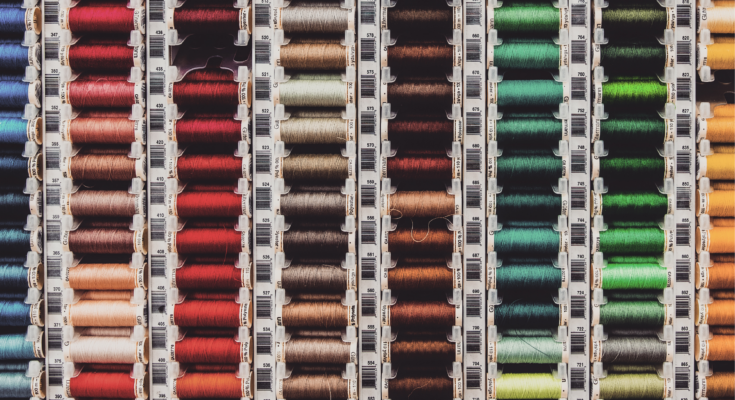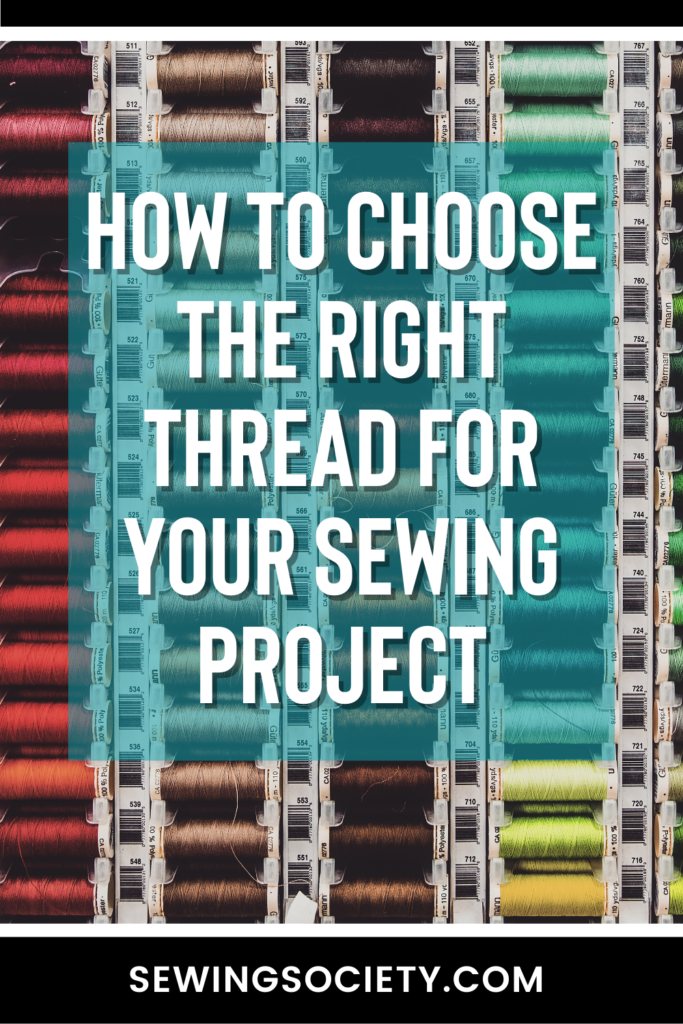Disclosure: This post may contain affiliate links. I earn a small commission when you click a link and make a purchase. Thanks for supporting SewingSociety.com!
Have you ever stared blankly at the wall of thread at your local craft store and wondered which type was the best for your project?
There are so many things to consider besides color!
Most people just reach for the ‘All-Purpose thread.’ Because as the name suggests, it is for all purposes. However, that doesn’t mean it is truly the best option for your sewing project.
I want to demystify that thread wall for you and show you how to choose the best thread for your sewing project.
Thread Types
Before I got an embroidery machine, all thread was basically the same to me. I would always pick up a spool of Gutermann thread because my mom told me it was the best…
Understanding the different thread types will help you a lot — each has its own set of pros and cons. Choosing the right thread really can make a huge difference in your sewing projects.
- All Purpose Thread: This is the most well-known and used thread type. It is usually made from 100% polyester but is sometimes a cotton/poly blend. All-Purpose thread is typically the least expensive thread and a good choice for most sewing projects. However, the drawback is that it cannot withstand a lot of heat.
- Invisible Thread: This thread is perfect if you do not want your thread to show on your project. However, it does not withstand heat at all and will likely melt, so you should only use it on projects you will not be ironing.
- Embroidery Thread: This thread is thinner than All-Purpose thread. It breaks easily and should only be used for decorative stitches and embroidery work. However, don’t confuse embroidery thread with embroidery floss. Embroidery floss is for hand stitching. Metallic thread is a type of embroidery thread that is wrapped in metallic polyester.
- Elastic Thread: This thread is mainly used for shirring, smocking, and gathering. Elastic thread is used in the bobbin while simultaneously using normal thread in the needle.
- Heavy Duty Thread: This is a very thick, durable thread. It is sometimes called upholstery thread. Heavy duty thread is not a good choice for all sewing projects because it is stiff and may irritate your skin. It can also easily jam your sewing machine.
- Quilting Thread: This thread has a similar weight to All-Purpose thread, but it is made from 100% cotton. It is fairly inexpensive and is mainly used for cotton quilts. Quilting thread does not stretch so it can be fragile when sewing clothing.
- Nylon Thread: This thread is stretchable, but a little tricky to use. When you sew knit fabric, you need to use a stretch stitch or nylon thread. This allows your seams to stretch with your fabric and not break.
- Serger Thread: This thread typically comes in large cones that you use with a serger. If you look closely at serger thread, it looks fuzzy. It does not hold up as well as All-Purpose thread and is best used for finishing seams.
- Top-Stitching Thread: This thread is typically thick, such as jeans thread. It is meant to be seen in your sewing projects.
Thread Fiber Make Up
Thread can be made from a variety of fibers. Cotton and polyester are the most common.
It’s nice to match the thread makeup with your fabric. For example, if you’re sewing silk, you could use silk thread. This is not always possible, but it is something to consider.
- Cotton: Resists heat, does not stretch, and deteriorates over time.
- Polyester: Lasts long and does not shrink but is less absorbent than cotton.
- Nylon: Is highly elastic with good recovery but will melt with heat.
- Silk: Is fine, strong, and flexible.
- Wool: Is durable, wicks away moistures, and takes dye well.
- Rayon: Is weak but has a high shine.
Thread Weight
Thread comes in different weights. This refers to how thick it is. All-Purpose thread is typically 50wt and embroidery thread is typically 60wt. Heavy duty thread has the lowest weight number and invisible thread has the highest.
Yes, this seems backwards… But, the smaller the number, the thicker the thread.
This is all you really need to know about thread weight because there is no standardized way to measure thread weight from brand to brand. Just keep in mind that thread with a high weight will break the easiest.
Additionally, thread has a tendency to get weaker with time, especially cotton thread. Also Read: Does Sewing Thread Go Bad?
Thread Color
While it’s helpful to know about the different types of thread, thread color should obviously be one of your biggest concerns when choosing thread for a sewing project. You should choose something that will blend in with your fabric.
One simple trick I learned from my mom a long time ago is to pull out a strand of thread from the spool and hold it against the fabric you’re going to sew. This makes it easier to see how it will look as a seam.
Most types of thread come in a vast array of colors. However, if you can’t find a perfect match for your fabric, choose something a little darker so it won’t stand out. Of course, using a high-contrast thread color can also be fun. Variegated thread can also create some pretty cool effects. The choice of color is solely preference.
If you need even more help with understanding thread, get The Ultimate Thread Guide book. Not only does it describe thread types in more detail, but it tells you which needle size to use with your thread!
I hope this post has been helpful. Choosing thread for your sewing project doesn’t have to be overwhelming. When in doubt, it usually is ok to choose that All-Purpose thread.
Share this post on Pinterest!






5 Comments on “Types of Thread: How to Choose the Right Thread for Your Sewing Project”